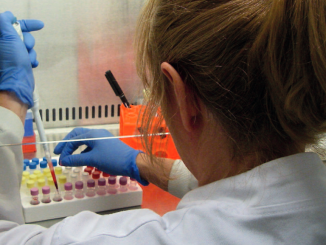Precision cancer medicine has put a spotlight on the role of pathologist, whose job it is to provide an accurate diagnosis as well as prognostic and predictive information on which to tailor the treatment plan. Cancer World asked Dina Tiniakos, President of the European Society of Pathology, how pathologists are rising to the challenge.
Cancer World: Cancer pathology was once all about grade, size and spread. Has the era of precision medicine changed that?
 Dina Tiniakos: Histological interpretation is still the main diagnostic tool in surgical pathology. The role of morphology in the molecular era will remain significant, as emerging morpho-molecular correlations enable the prediction of underlying molecular changes based on histological subtyping, at least in some types of cancer. In addition to established prognostic information based on tumour size, histological grade, depth of invasion and lymph node spread, pathologists can now provide additional prognostic and predictive data at the tissue level, such as cell proliferation indices for neuroendocrine neoplasms, hormone and tyrosine kinase receptor expression in breast carcinoma, response to immunotherapy by assessing PD and PD-L1 expression or indirect information on gene mutations, e.g. beta-catenin mutation in hepatocellular adenoma, which is indicative of higher risk for malignant transformation. During the last two decades molecular diagnostic technology has progressively expanded and, with the growing demands for molecular tumour subclassification and information on prognosis, response to treatment and molecular therapeutic targets, this field will expand further.
Dina Tiniakos: Histological interpretation is still the main diagnostic tool in surgical pathology. The role of morphology in the molecular era will remain significant, as emerging morpho-molecular correlations enable the prediction of underlying molecular changes based on histological subtyping, at least in some types of cancer. In addition to established prognostic information based on tumour size, histological grade, depth of invasion and lymph node spread, pathologists can now provide additional prognostic and predictive data at the tissue level, such as cell proliferation indices for neuroendocrine neoplasms, hormone and tyrosine kinase receptor expression in breast carcinoma, response to immunotherapy by assessing PD and PD-L1 expression or indirect information on gene mutations, e.g. beta-catenin mutation in hepatocellular adenoma, which is indicative of higher risk for malignant transformation. During the last two decades molecular diagnostic technology has progressively expanded and, with the growing demands for molecular tumour subclassification and information on prognosis, response to treatment and molecular therapeutic targets, this field will expand further.
CW: How confident can oncologists be that the pathology reports they use to guide treatment decisions are reliable and would be replicated in other labs/centres/countries?
DT: Internal quality assurance (IQA) systems are in place in most pathology laboratories in Europe. This ensures testing of quality of histological techniques, special histochemical stains, immunohistochemistry, and molecular diagnostic methods. In addition, external quality assurance (EQA) programmes, also known as proficiency testing, are key tools to periodically assess all the above by inter-laboratory comparison. These assist laboratories in monitoring their assays and improving their performance, as well as with evaluation of results whenever needed. The European Society of Pathology (ESP) and other organisations run such EQA programmes continuously to ensure optimal accuracy and proficiency for biomarker testing across all participating countries.
For the accuracy of molecular diagnostic testing, the quality of tissue for analysis is the most important variable, and the pre-analytical phase plays a major role. Simple steps, such as specimen fixation, are critical in ensuring that the tissue available for testing will be of optimal quality. Therefore, ‘tissue is the issue’ and will continue to be, whatever new diagnostic technology will be implemented. Accreditation of pathology laboratories according to quality standards is becoming more common in continental Europe after its introduction almost three decades ago in the UK.
Of course, certifying that pathologists are adequately trained, their diagnostic skills are appropriate, and their knowledge is up to date, is critical for the reliability of histopathological diagnosis. For this reason, more countries now follow the UK example, where EQA programmes for different pathology subspecialties testing the competency of pathologists are run once or twice a year.
CW: What are the biggest barriers to improving pathology practice, and how is the ESP addressing them?
DT: The ESP promotes high-quality diagnostic practice, applied and translational research, and under- and post-
graduate education in the field of human pathology. The biggest barrier to improving pathology practice in Europe is the heterogeneity of pathology services among different countries. Through our educational programmes and by working closely with the national societies of pathology, the ESP strives to diminish inequalities in postgraduate education in pathology, including molecular pathology. The ESP Foundation provides EQA programmes that enable participating laboratories to monitor their performance in specific molecular testing, ensuring high-quality services.
CW: What challenges do tumour heterogeneity and clonal evolution pose for pathologists?
DT: Genetic tumour heterogeneity can lead to underestimation of the tumour genomic landscape portrayed from a single diagnostic biopsy or surgical specimen, and may present major challenges to personalised medicine and biomarker development and validation. Genomic diversity within a given tumour, as well as temporal heterogeneity as the tumour evolves, may lead to erroneous results regarding the underlying key genetic changes, and may lead to therapeutic failure, especially when treatment is based on results from a minute tissue sample.
The challenges for molecular diagnostics are basically paralleled across all types of tumours, and resolving these issues will require technology improvements in addition to a greater understanding of tumour biology. Sampling from more than one site within the tumour and re-assessing the tumour following recurrence are ways to overcome this problem. For the latter, circulating biomarkers may prove useful to monitor and/or modify treatment. The logistical challenges of implementing the next generation of molecular diagnostics into clinical practice are equally important, taking into account the need for multiple tumour sampling. More investment is therefore warranted in information technology infrastructure, data storage, pathways in sample processing, and training and professional developments in histopathology.
CW: Will pathologists need to play more of a role beyond the initial diagnosis, and if so, how will that affect capacity issues?
DT: One of the current challenges in pathology is that pathologists need to adapt methods and techniques in the laboratory to meet the new therapy options and modalities, with immunotherapy as the best example. The course of neoplastic disease during immunotherapy is still not fully predictable, making prognosis even more difficult. A key recommendation for preventing therapy resistance, owing to tumour heterogeneity and cancer adaptation, is to perform frequent tumour biopsies to monitor emergence of new aberrations and eradicate significant sub-clones as early as possible. It can be anticipated that, in the era of precision medicine, the number of molecular markers that need to be assessed will steadily increase per sample. The challenge for the diagnostic laboratory is to select high-performing technological methodologies that enable reliable detection of all mutations required, at a high sensitivity, with a limited amount of tissue, within short turn-around times and at low cost.
A further challenge is the low rates of recruitment of pathology trainees, which poses additional stresses on the capacity of laboratories to face the increasing numbers of sample testing that will be required in the future. It is envisaged that artificial intelligence systems will aid pathologists in performing simple measurements of cells positive for a given biomarker or counting in situ hybridisation signals, allowing them to concentrate on the more complex process of histological interpretation, which is the cornerstone of cancer diagnosis.
Dina Tiniakos is President of the European Society of Pathology (2017‒2019). She is Professor of Pathology at the National & Kapodistrian University of Athens, Greece, an academic pathologist at the Institute of Cellular Medicine at Newcastle University, UK, and sits on the Board of the International Quality Network for Pathology. She is also Director of the Department of Pathology at Aretaieion University Hospital in Athens, and specialises in hepatobiliary pathology.





